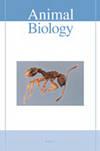棉中天然精油对小飞虱和烟粉虱的引诱作用
IF 0.9
4区 生物学
Q2 ZOOLOGY
引用次数: 0
摘要
小飞虱(Amrasca biguttula biguttula)和粉虱(Bemisia tabaci)是棉花最具经济效益的吸棉害虫,可造成发育迟缓、节间缩短和传播植物致病病毒。这些害虫的管理主要是基于使用合成杀虫剂,这不仅会引发对杀虫剂分子的抗性,而且会造成环境污染。本实验采用黄色粘捕器,在田间条件下研究了大叶小蠊和烟粉虱对檀香、罗勒、葡萄柚、玫瑰、丁香和薄荷等6种天然精油的引诱作用。结果表明:2016-2017和2017-2018两季,檀香油和罗勒油处理的诱捕器对大褐刺螨和烟粉虱的诱捕量显著高于其他诱捕器;此外,檀香和罗勒精油对这些害虫的吸引指数(AI)显著较高(即bbb1)。此外,用檀香和罗勒油处理的陷阱捕获的天敌数量相对较少。GC-MS分析指出檀香中存在重要的挥发性化合物,即檀香烯、funebrene和pentadecane;还有罗勒油中的芳樟醇,β-法尼烯,石竹烯和甲基丁香酚。结果表明,紫檀油和罗勒油的施用提高了粘捕器对棉花上大灰螨和烟粉虱的引诱效果。本文章由计算机程序翻译,如有差异,请以英文原文为准。
Attraction of leaf hopper, Amrasca biguttulla biguttulla, and whitefly, Bemisia tabaci, toward natural essential oils in cotton
Leaf hopper, Amrasca biguttula biguttula, and whitefly, Bemisia tabaci are the most economical sucking pests of cotton (Gossypium spp.) causing stunting, shortening of internodes and transmitting plant pathogenic viruses. The management of these pests is primarily based on application of synthetic pesticides, which not only triggers resistance to insecticide molecules but also contributes to environmental pollution. We aimed to study the attraction of A. biguttula and B. tabaci toward six natural essential oils (NEOs) viz., sandalwood, basil, grapefruit, rose, clove and mint oils using yellow sticky traps under field conditions. The results showed that traps treated with sandalwood and basil oils attract significant numbers of A. biguttula and B. tabaci as compared to the other traps during the seasons 2016-2017 and 2017-2018. Further, the Attractive Index (AI) of sandalwood and basil oils to these pests were significantly higher (i.e., >1). In addition, the traps treated with sandalwood and basil oils caught relatively lower numbers of natural enemies. The GC-MS analysis specified the presence of vital attractive volatile compounds, viz., santalene, funebrene and pentadecane in sandalwood; and linalool, β-farnesene, caryophyllene and methyl eugenol in basil oil. Based on the results obtained it can be concluded that application of sandalwood and basil oils increased the attracting efficacy of sticky traps for the management of A. biguttula and B. tabaci in cotton.
求助全文
通过发布文献求助,成功后即可免费获取论文全文。
去求助
来源期刊

Animal Biology
生物-动物学
CiteScore
2.10
自引率
0.00%
发文量
34
审稿时长
3 months
期刊介绍:
Animal Biology publishes high quality papers and focuses on integration of the various disciplines within the broad field of zoology. These disciplines include behaviour, developmental biology, ecology, endocrinology, evolutionary biology, genomics, morphology, neurobiology, physiology, systematics and theoretical biology. Purely descriptive papers will not be considered for publication.
Animal Biology is the official journal of the Royal Dutch Zoological Society since its foundation in 1872. The journal was initially called Archives Néerlandaises de Zoologie, which was changed in 1952 to Netherlands Journal of Zoology, the current name was established in 2003.
 求助内容:
求助内容: 应助结果提醒方式:
应助结果提醒方式:


